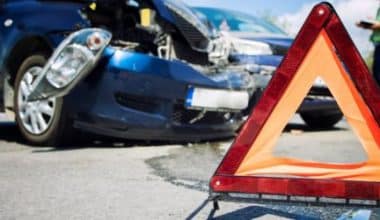Full-coverage car insurance, which combines liability, comprehensive, and collision policies, is sufficient to cover all but the most unlikely events. Whether or not other drivers opt for insurance, you should take steps to protect yourself on the road by purchasing the appropriate policy. The rental car company may provide you with four different types of insurance coverage: loss damage waiver (LDW), liability coverage, personal accident insurance, and personal effects coverage.
Learn about the various car insurance coverage types available to you below.
Types of Car Insurance Coverages
There are many types of car insurance coverage that several companies offer motorists. Some are standard car insurance, while others can be added as riders. The following are the main types of car coverages in the insurance industry:
#1. Liability Coverage
Anyone who owns or operates a motor vehicle should have liability insurance at the very least. If you do not have liability insurance, you would have to pay for any damage you cause to someone else’s car or person. Most states’ legislation mandates this.
Every state requires drivers to have liability insurance, except New Hampshire (where drivers are exempt from carrying auto insurance if they meet the state’s minimum financial responsibility requirements) and Virginia (where drivers can opt out of purchasing insurance by paying an uninsured motorist fee of $500).
Types of Liability Insurance
Most states’ minimum liability insurance requirements include protection against bodily injury and property damage. When you hit someone or something, bodily injury coverage will help pay for medical bills, while property damage coverage will help pay for repairs to the other vehicle or the damaged property.
#1. Bodily Injury Liability Insurance (BI)
When you cause bodily harm to another person and are found legally responsible, your liability insurance will help cover their medical bills and other associated costs. People who are listed as drivers on your policy, including yourself, can use this coverage. Medical costs, legal representation, lost wages, emotional distress, etc. are all covered by this policy. The minimum amount of bodily injury liability insurance required by your state can be found in its statutes.
Bodily injury coverage on a car insurance policy might read $25,000/$50,000. This means that you are covered for up to $50,000 in bodily injury per accident and up to $25,000 per person.
#2. Property Damage Liability Insurance (PD)
Your liability insurance will foot the bill if you accidentally cause damage to another person’s property. It pays for repairs to the other driver’s vehicle or other property you may damage. “Other property” can refer to things like walls, fences, and even mailboxes, and other equipment.
If you cause damage to someone else’s home, the insurance company will cover the cost. Let us say you are driving through a residential area when the brakes suddenly fail you. You lose control of your vehicle and careen off the road, crashing through someone’s yard and onto their porch.
If that were to happen, your property damage liability insurance would pay for any necessary repairs to the house up to the policy’s maximum. Afterward, if there is still money needed to finish the repairs, the policyholder can collect it from their insurer. A typical property damage coverage limit on an auto insurance policy is $25,000.
#2. Full Coverage
Leasing or loaning a car requires you to have collision and comprehensive insurance. It covers losses due to hazards like fire, theft, vandalism, broken glass, and animal attacks. When you buy comprehensive coverage, you have to pay a small amount of money upfront before your insurance starts to pay for things.
It is not required by law, but if you want to finance or lease a car from a bank, you will need this coverage. In addition to collision insurance, comprehensive protection is recommended for people who still owe money on their car or who drive a newer, more expensive model.
Theft, fire, vandalism, extreme weather, and falling objects are just some of the non-collision events for which your car will be compensated under this policy.
#3. Uninsured Insurance or Underinsured Insurance
If someone without insurance hits you, uninsured motorist coverage will cover your medical expenses and vehicle repairs. In the event of a hit-and-run accident, this insurance will typically cover your expenses.
Underinsured motorist coverage is similar to collision coverage, but it kicks in when the other driver does not have enough liability insurance to cover your losses when they hit you or your vehicle. Let us say someone hits you but only has the state-required minimum amount of liability insurance. If your damages are greater than their cap, underinsured motorist coverage would take over to cover the difference.
To safeguard yourself, your passengers, and your vehicle, it is important to have coverage for both uninsured and underinsured motorists. While not always necessary, all drivers should have insurance to protect themselves from having to pay for accidents they did not cause.
This type of insurance covers medical and injury-related expenses for you or your passengers if you’re in an accident with an uninsured driver. May also cover damages to your vehicle, depending on your state.
In the event of an accident in which the at-fault driver does not have auto insurance, uninsured motorist bodily injury coverage (UMBI) will pay for your medical bills, lost wages, and other costs associated with the incident. If an uninsured driver causes an accident, your insurance policy will pay for your vehicle’s repairs.
#4. Collision Coverage
Your collision insurance will pay for any repairs necessary because of an accident. As with comprehensive, this type of insurance is voluntary and not mandated in any given jurisdiction. However, the financial institution that provides your auto loan or lease agreement will insist that you buy collision insurance. You will also need to pay a deductible, so pick one that you can easily pay if you need to make a claim. In the event of a claim, the insurance company will pay out the actual cash value of the vehicle. If your car is damaged in a collision with something else, like another vehicle or a pole, collision insurance will pay for the repairs.
#5. Personal Injury Protection
If you or a passenger in your car are injured in a collision, personal injury protection (PIP) will pay for medical expenses. This insurance is unlike others because it pays out no matter who is at fault. PIP benefits are available regardless of fault for the accident. In addition, it safeguards you while you are walking. As a result, if you were walking or riding your bike and a car struck you, your PIP coverage might cover your medical expenses.
But keep in mind that it is not accessible in every state. Only the following 12 states mandate PIP coverage:
- Delaware
- Florida
- Hawaii
- Kansas
- Massachusetts
- Michigan
- Minnesota
- New Jersey
- New York
- North Dakota
- Oregon
- Utah
#6. Medical Payment Coverage
If you or a passenger in your car sustains injuries in a collision, medical payments coverage will help cover the costs. The policy will pay out no matter who is at fault.
Lost wages and death benefits are typically not covered by medical payment plans like PIP. If you already have medical insurance, it may be unnecessary. You should think about your passengers, though. If they suffered an injury in your car, they could receive medical care, but your health insurance would not pay for it.
Adding it to your policy for a low premium can be a lifesaver if an accident occurs while you are behind the wheel. Medical payment coverage is essential for those without health insurance in the event of an accident. No matter who caused the accident, your medical costs will be covered.
Other Kinds of Optional Car Insurance Coverage
In addition to the six main types of auto insurance described above, you might be able to include additional coverage options on your policy, depending on the insurer you choose.
The other types of car insurance coverages include:
- Roadside assistance insurance
- New car replacement coverage
- Gap insurance
- Towing and labor insurance
- Death and disability coverage
- Rental car reimbursement insurance
Types of Rental Car Insurance Coverages
The rental car company may provide you with four different types of insurance coverage: loss damage waiver (LDW), liability coverage, personal accident insurance, and personal effects coverage.
#1. Rental Car Liability Insurance
You can also purchase liability auto insurance from your rental car company. If you cause an accident and other people’s cars and people get hurt, this will pay for their medical bills and repairs. If the trip is not for business purposes, your liability insurance will cover it. This will pay for repairs to other people’s vehicles and other damage you cause. Even though you are operating a rental vehicle, your personal liability coverage may still apply.
#2. Rental Car Loss-damage Waiver Insurance
By choosing this option, you are exempt from having to make any payments for theft, vandalism, total losses, environmental damage, accidents, or other damages. Similar insurance is collision damage waiver (CDW), but it excludes theft protection. For the rental, these waivers essentially serve as collision and comprehensive insurance. If you already have collision and comprehensive insurance, there is probably no reason to purchase this. Another thing to think about is that if you get a loss damage waiver, you will not have to worry about paying a deductible.
This is a waiver, not an actual insurance policy, and is sometimes referred to as CDW. In essence, it states that you are immune from legal action by the rental car company in the event of damage to or theft of the rental vehicle. However, it’s possible that your collision and comprehensive coverage already cover this.
#3. Personal Accident Car Rental Insurance
In the event of an accident, this insurance will cover medical expenses for you and your passengers. It is very similar to the PIP and MedPay coverage found on most standard automobile insurance policies. After you have paid your deductible, your health insurance policy may cover any medical expenses not covered by your auto insurance policy.
A deductible is not necessary for personal accident coverage. In the event of an accident, personal accident coverage will pay for the medical care of you and your passengers. If you have personal injury protection or medical payments, the coverage under your current policy might apply to you.
#4. Rental Car Personal Effects Coverage
You can purchase this extra coverage to safeguard valuables like electronics, luggage, and clothing. Your homeowner’s or renter’s insurance will also reimburse you for stolen belongings from a rental car, if you have one. If something is stolen from your rental car, you will not have to worry because this insurance has you covered. Your existing home or apartment insurance policy may provide equivalent protection.
Other Types of Car Rental Insurance Coverages
You may also be covered by your credit card insurance or a separate travel insurance policy in addition to the rental car company’s offerings.
#1. Credit Card Rental Car Insurance
The primary insurance for rental cars is frequently included with premium credit cards. Primary coverage has high limits and can pay for the entire claim without notifying your insurance company. This prevents an increase in your monthly premiums.
Standard cards, on the other hand, typically feature secondary protections. You will have to go through your insurance provider to make a claim, and the limits are lower. In either case, you will need to use the credit card to reserve the rental car to be covered.
#2. Car Rental Travel Insurance
Travel insurance policies typically offer coverage for collisions and loss of use at a cost that is more affordable compared to what the rental car company charges for these additional services.
#3. International Car Rental Insurance
It is possible (but not guaranteed) that your auto insurance will not cover car rentals made in Mexico or Canada. If you want to know, it is best to check with your travel agent in advance. Rental car insurance is recommended if driving abroad because most U.S. auto insurance policies do not cover rentals outside the country.
Full Coverage Car Insurance
Comprehensive, collision, and liability coverage are the three main components of what is known as “full coverage” auto insurance. It protects you from a wide range of potential losses, including natural disasters, accidents in which you are found at fault, animal strikes, and acts of vandalism. Full coverage insurance is something to consider if you have a new car, live in an area with extreme weather, or are making payments on a car loan or lease.
When people talk about “full coverage,” they usually mean an auto policy that includes not only liability coverage but also comprehensive collision protection. This package deal will cover not only repairs to your vehicle but also any injuries or property damage you may cause to other people. Complete auto insurance typically covers the following:
- If you cause harm to another person or their property, liability insurance will help cover the costs.
- Collision insurance covers damage to vehicles brought on by collisions.
- If something happens to your car that you can not control, like a natural disaster or theft, comprehensive insurance will help cover the costs.
- Personal Injury Protection (PIP), Uninsured Motorist Coverage (UM), and Rental Car Coverage are all examples of optional coverages.
Legally, only liability insurance is required for motor vehicles. The minimum liability insurance required by most states does not protect you from accidents or medical bills; it only reimburses the other party. After an accident, having full coverage will protect you financially more than the bare minimum required by most states.
What Does Full Coverage Car Insurance Cover?
Full coverage insurance covers damage to your vehicle resulting from a storm, an accident in which you were at fault, colliding with an animal, or vandalism. Full-coverage insurance will reimburse you for the market value of your vehicle in the event of theft, making it possible to buy a new vehicle.
When you have full coverage, medical bills, and property damage caused by your car are paid for by your insurance company. If you are at fault in an accident, or if severe weather, theft, or other events damage your vehicle, your insurance will cover the costs of repairs. The policy may also cover injuries to other people or drivers who do not have insurance.
However, even “full coverage” car insurance policies may not encompass every type of protection that has been described. Add-ons such as new-car replacement, roadside assistance, and coverage for aftermarket components and installations may not come standard.
How Much Is Full Coverage Car Insurance?
According to NerdWallet’s projections, a 35-year-old safe driver with a spotless driving record and excellent credit can expect to pay $2,148 annually, or about $179 monthly, for full-coverage auto insurance in 2023. That is more than twice the cost of the bare minimum in liability coverage, so it is important to compare quotes from multiple providers to find the best deal.
What Type of Insurance is Best for a Car?
Comprehensive Car Insurance Policy This insurance policy offers the highest level of safety possible. It shields you from both repairs to your car and legal action brought against you by others. In the event of your untimely demise as the result of an accident, a full coverage policy will provide financial support to your loved ones. When it comes to auto insurance, comprehensive policies offer the most protection.
What Is the Cheapest Form of Car Insurance?
The bare minimum of liability coverage required by your state is the most affordable option. Since it provides the least amount of protection, liability insurance is typically the most inexpensive option. It can help pay for repairs to other people’s homes and vehicles if you cause an accident. Things like legal repercussions, property damage, and medical costs all fall under this category. Virtually every state mandates that drivers carry at least some level of liability coverage.
What Types of Insurance Are Not Recommended?
- Private mortgage insurance
- Rental Car Insurance
- Car Rental Damage Insurance
- Flight insurance.
- Water Line Coverage
- Life insurance for children
- Extended warranties
- Flood insurance.
What Type of Car Has the Highest Insurance Rate?
Some of the most expensive vehicles to insure are Dodges, Teslas, and BMWs. The Maserati Quattroporte tops the list of most expensive cars to insure, with annual premiums of $5,024, or $419 monthly; this is 239 percent higher than the national average for car insurance.
What Is Comprehensive Coverage?
For those who wish to safeguard their vehicles from the financial consequences of non-collision events beyond their control, comprehensive insurance is a good choice. Theft, vandalism, broken glass or windshields, fire, animal attacks, bad weather, and other natural disasters all fall under this category.
What Is the Most Basic Form of Car Insurance?
The legal minimum of coverage for a car is called Liability Insurance, or Third Party Insurance. The majority of states mandate a minimum coverage amount for these types of insurance.
What Is the Best Way to Lower Your Car Insurance?
- Raise your deductible.
- Look for discounts that you can get.
- Compare prices on car insurance.
- Always be a safe and responsible driver.
- Take part in a driver education course.
- Participate in a defensive driving program.
- Explore payment options.
- Raise that credit rating of yours.
Conclusion
Full coverage comes at a high price. In some cases, such as when a car is more than 10 years old or its value drops below $5,000, dropping full coverage is the best option.
When the value of your car falls to between six and ten times your annual premium for comprehensive and collision insurance, it is usually more cost-effective to forego full coverage and shoulder the financial burden of repairs yourself.
- Liability vs Full Coverage Car Insurance 2023: Which Is Better?
- WHAT IS LOSS OF USE COVERAGE IN HOME INSURANCE?
- TOP BEST INSURANCE FOR NEW DRIVERS 2023
- BEST CAR INSURANCE YOUNG DRIVERS FOR 2023
- Property Damage Liability Insurance: Protect Yourself from Financial Loss






